—Dr. Lillian Faderman, historian, author of
Odd Girls and Twilight Lovers
“A scholarly, exhaustive, and utterly convincing refutation of the notion that human homosexuality is an aberration in nature…. Bagemihl does realize that some among us will never be convinced that homosexuality occurs freely and frequently in nature. But his meticulously gathered, cogently delivered evidence will quash any arguments to the contrary.”
—
Kirkus Reviews
The following is a partial list of other species in which homosexual behavior has been documented, including reptiles/amphibians, fishes, insects and other invertebrates, and domesticated animals.
Abbreviations are used to indicate the general type of homosexuality (and in some cases, transgender) for each species:
F = female homosexuality
M = male homosexuality
FTvM = female-to-male transvestism
MTvF = male-to-female transvestism
P = parthenogenesis
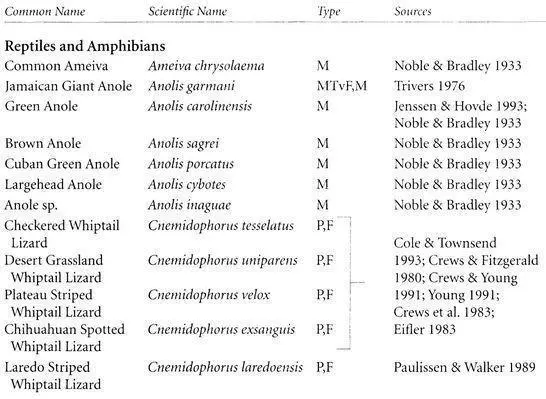
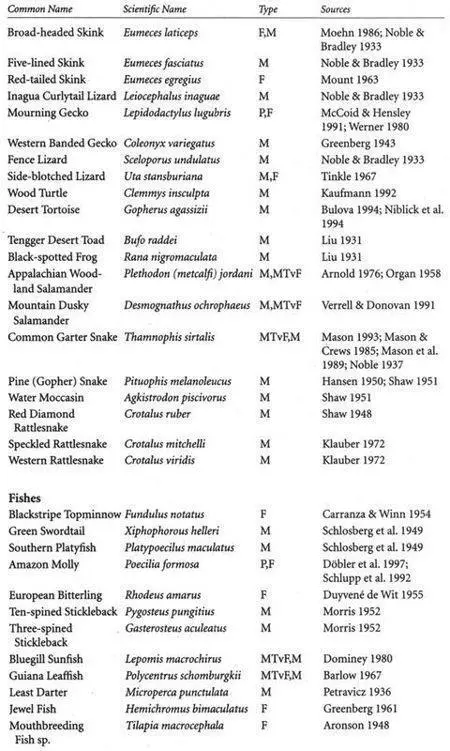
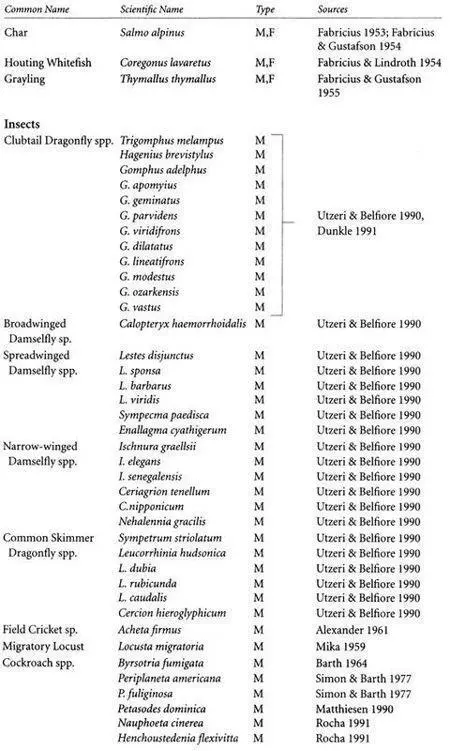
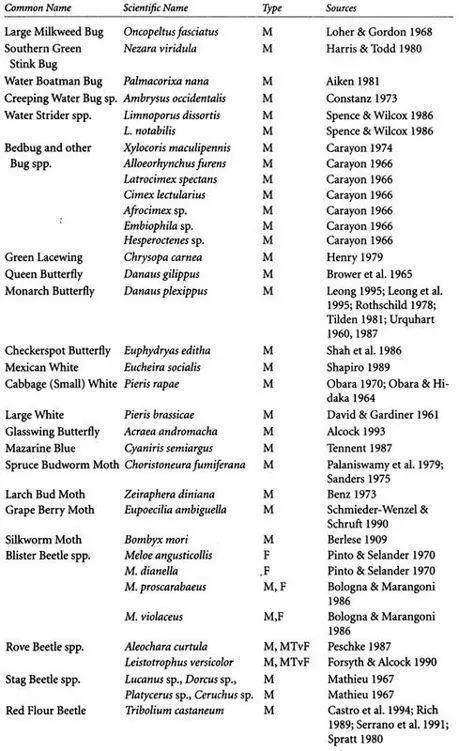
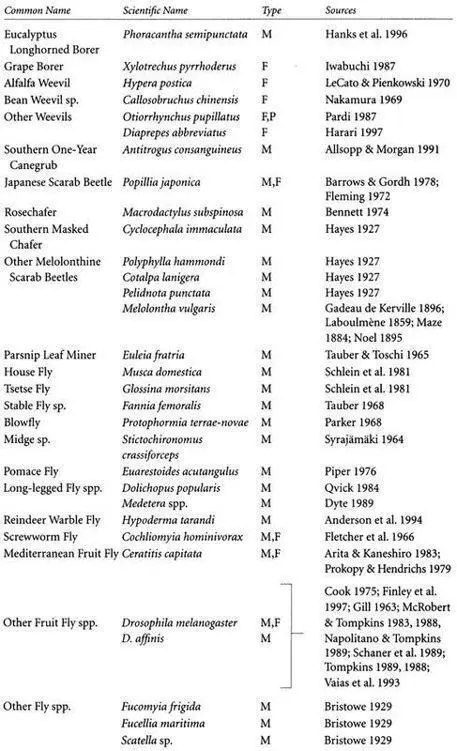
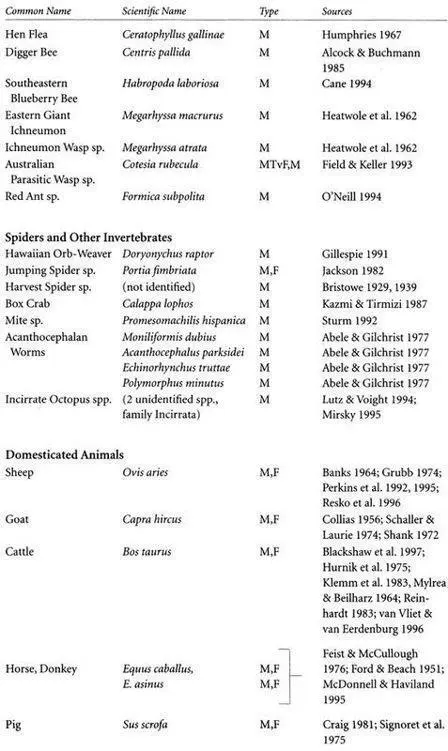
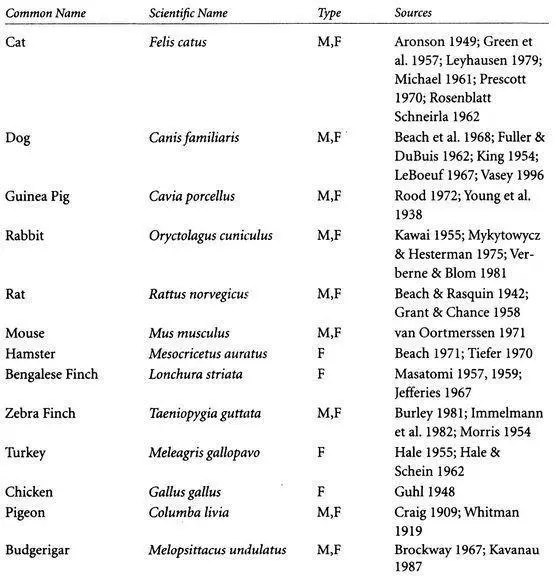
Reptiles and Amphibians
Arnold, S. J. (1976) “Sexual Behavior, Sexual Interference, and Sexual Defense in the Salamanders Ambystoma maculatum, Ambystoma trigrinum , and Plethodon jordani.” Zeitschrift für Tierpsychologie 42:247–300.
Bulova, S. J. (1994) “Patterns of Burrow Use by Desert Tortoises: Gender Differences and Seasonal Trends.” Herpetological Monographs 8:133–43.
Cole, C. J., and C. R. Townsend (1983) “Sexual Behavior in Unisexual Lizards.” Animal Behavior 31:724–28.
Crews, D., and K. T. Fitzgerald (1980) “‘Sexual’ Behavior in Parthenogenetic Lizards (Cnemidophorous).” Proceedings of the National Academy of Sciences 77:499–502.
Crews, D., and L. J. Young (1991) “Pseudocopulation in Nature in a Unisexual Whiptail Lizard.” Animal Behavior 42:512–14.
Crews, D., J. E. Gustafson, and R. R. Tokarz (1983) “Psychobiology of Parthenogenesis.” In R. B. Huey, E. R. Pianka, and T. W. Schoener, eds., Lizard Ecology: Studies of a Model Organism, pp. 205–31. Cambridge: Harvard University Press.
Eifler, D. A. (1993) “Cnemidophorus uniparens (Desert Grassland Whiptail). Behavior.” Herpetological Review 24:150.
Greenberg, B. (1943) “Social Behavior of the Western Banded Gecko, Coleonyx variegatus Baird.” Physiological Zoology 16:110–22.
Hansen, R. M. (1950) “Sexual Behavior in Two Male Gopher Snakes.” Herpetologica 6:120.
Jenssen, T. A., and E. A. Hovde (1993) “Anolis carolinensis (Green Anole). Social Pathology.” Herpetological Review 24:58–59.
Kaufmann, J. H. (1992) “The Social Behavior of Wood Turtles, Clemmys insculpta, in Central Pennsylvania.” Herpetological Monographs 6:1–25.
Klauber, L. M. (1972) Rattlesnakes: Their Habits, Life Histories, and Influence on Mankind. Vol. 1. Berkeley: University of California Press.
Liu, Ch’eng-Chao (1931) “Sexual Behavior in the Siberian Toad, Bufo raddei and the Pond Frog, Rana ni-gromaculata.” Peking Natural History Bulletin 6:43-60.
Mason, R. T. (1993) “Chemical Ecology of the Red-Sided Garter Snake, Thamnophis sirtalis parietalis.” Brain Behavior and Evolution 41:261-68.
Mason, R. T., and D. Crews (1985) “Female Mimicry in Garter Snakes.” Nature 316:59–60.
Mason, R. T., H. M Fales, T. H. Jones, L. K. Pannell, J. W. Chinn, and D. Crews (1989) “Sex Pheromones in Snakes.” Science 245:290-93.
McCoid, M. J., and R. A. Hensley (1991) “Pseudocopulation in Lepidodactylus lugubris.” Herpetological Review 22:8-9.
Moehn, L. D. (1986) “Pseudocopulation in Eumeces laticeps.” Herpetological Review 17:40–41.
Moore, M. C., J. M. Whittier, A. J. Billy, and D. Crews (1985) “Male-like Behavior in an All-Female Lizard: Relationship to Ovarian Cycle.” Animal Behavior 33:284-89.
Mount, R. H. (1963) “The Natural History of the Red-Tailed Skink, Eumeces egregius Baird.” American Midland Naturalist 70:356–85.
Niblick, H. A., D. C. Rostal, and T. Classen (1994) “Role of Male-Male Interactions and Female Choice in the Mating System of the Desert Tortoise, Gopherus agassizii.” Herpetological Monographs 8:124–32.
Noble, G. K. (1937) “The Sense Organs Involved in the Courtship of Storeria, Thamnophis, and Other Snakes.” Bulletin of the American Museum of Natural History 73:673–725.
Noble, G. K., and H. T. Bradley (1933) “The Mating Behavior of Lizards; Its Bearing on the Theory of Sexual Selection.” Annals of the New York Academy of Sciences 35:25–100.
Organ, J. A. (1958) “Courtship and Spermatophore of Plethodon jordani metcalfi” Copeia 1958:251-59.
Paulissen, M. A., and J. M. Walker (1989) “Pseudocopulation in the Parthenogenetic Whiptail Lizard Cneimidophorous laredoensis (Teiidae).” Southwestern Naturalist 34:296-98.
Shaw, C. E. (1951) “Male Combat in American Colubrid Snakes With Remarks on Combat in Other Colubrid and Elapid Snakes.” Herpetologica 7:149–68.
———(1948) “The Male Combat ‘Dance’ of Some Crotalid Snakes.” Herpetologica 4:137–45.
Tinkle, D. W. (1967) The Life and Demography of the Side-blotched Lizard, Uta stansburiana. Miscellaneous Publications, Museum of Zoology, no. 132. Ann Arbor: University of Michigan.
Trivers, R. L. (1976) “Sexual Selection and Resource-Accruing Abilities in Anolis garmani.” Evolution 30:253–69.
Verrell, P., and A. Donovan (1991) “Male-Male Aggression in the Plethodontid Salamander Desmognathus ochrophaeus.” Journal of Zoology 223:203–12.
Werner, Y. L. (1980) “Apparent Homosexual Behavior in an All-Female Population of a Lizard, Lepidodactylus lugubris and Its Probable Interpretation.” Zeitschrift für Tierpsychologie 54:144–50.
Fishes
Aronson, L. R. (1948) “Problems in the Behavior and Physiology of a Species of African Mouthbreeding Fish.” Transactions of the New York Academy of Sciences 2:33–42.
Barlow, G. W. (1967) “Social Behavior of a South American Leaf Fish, Polycentrus schomburgkii, with an Account of Recurring Pseudofemale Behavior.” American Midland Naturalist 78:215–34.
Carranza, J., and H. E. Winn (1954) “Reproductive Behavior of the Blackstripe Topminnow, Fundulus notatus.” Copeia 4:273–78.
Dobler, M., 1. Schlupp, and J. Parzefall (1997) “Changes in Mate Choice with Spontaneous Masculinization in Poecilia formosa.” In M. Taborsky and B. Taborsky, eds., Contributions to the XXV International Ethological Conference, p. 204. Advances in Ethology no. 32. Berlin: Blackwell Wissenschafts-Verlag.
Читать дальше



















